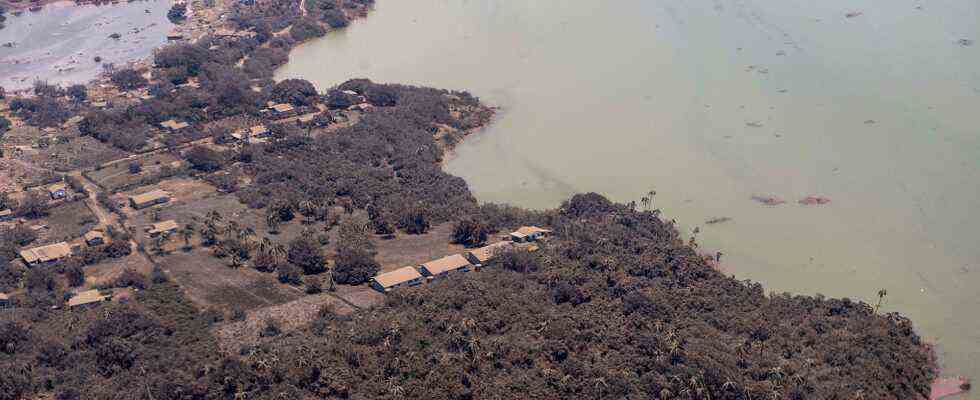Status: 01/18/2022 2:15 p.m
In a first official statement since the massive eruption of an undersea volcano, Tonga’s government has confirmed at least three deaths. Some remote islands are now being evacuated. Experts fear another outbreak.
After the volcanic eruption of the Hunga-Tonga-Hunga-Ha’apai and the subsequent tsunami on the islands of Tonga, a picture of the consequences of the natural disaster is gradually emerging.
In a first statement, the Tonga government reports at least three deaths. The Prime Minister’s Office has confirmed the deaths of a 65-year-old woman on Mango Island, a 49-year-old man on Nomuka Island and a British national. Several injuries were also reported.
Pictures show many destroyed houses
Images captured by New Zealand Defense Force (NZDF) reconnaissance aircraft showed “alarming” scenes of a destroyed village on Mango Island and missing buildings on nearby Atata Island, Tonga’s Deputy Ambassador to Australia Curtis Tu said ‘ihalangingie.
The volcano apparently collapsed as a result of the eruption, and it can hardly be seen on the latest satellite images.
Communication by satellite phone
Communication links to the islands of the archipelago are further affected because a key undersea cable was severed by the seaquake. So far, there has been no contact specifically with the Ha’apai archipelago, said the UN emergency relief office OCHA.
The World Health Organization’s liaison officer in Tonga, Yutaro Setoya, maintains communications between the UN agencies and the country’s government via his satellite phone, the WHO reports. Setoya has been standing outside for days “literally from sunrise until late at night to make sure the phone gets the satellite signal,” said WHO Pacific Coordinator Sean Casey.
However, the health facilities are functioning according to the WHO. There is concern about the thick layer of ash that may have contaminated water reservoirs. The population was asked to only drink bottled water.
Evacuation has started
According to OCHA, at least 50 houses have been destroyed and 100 others damaged in the South Seas archipelago of Tonga. The evacuation of some remote islands has begun, including an entire village on Mango Island. Severe damage near the coast was reported from the capital Nuku’alofa. The Tongan Navy has been dispatched to the offshore Ha’apai Islands with health teams and water, food and tents.
The Catholic charity Caritas Australia is preparing humanitarian aid for those affected. “We are currently working to re-establish communications with our local partners to assess the situation on the ground and identify the most pressing needs.”
Layer of ash prevents landings
A thick layer of ash at the airport in the capital Nuku’alofa is currently making it impossible for aid flights from New Zealand and Australia to land. The ashes must first be cleared before C-130 Hercules aircraft with humanitarian supplies can land, said New Zealand’s Foreign Minister Nanaia Mahuta and Defense Minister Peeni Henare, according to the government website.
Therefore, New Zealand will first send ships with relief supplies to Tonga, 2400 kilometers away. Defense Minister Peeni Henare stressed: “Water is the top priority for Tonga at this stage.”
More dead? Another outbreak?
After the tsunami triggered by the volcano, there is particular concern about the low-lying islands of Mango, Atata and Fonoi. An emergency signal was received from Mango, where around 50 people live. “People are panicking, running around and hurting. There may be more deaths,” said Tonga’s Deputy Ambassador to Australia, Curtis Tu’ihalangingie.
Numerous buildings have disappeared on the neighboring island of Atata, which has around 100 residents. “Apparently, the wave once completely rolled over Atata,” Tu’ihalangingie said.
In addition, experts fear that the submarine volcano continues to pose a threat. “I think it will erupt again in the coming days, weeks or months,” Australian broadcaster ABC quoted geochemist Oliver Nebel from the renowned Monash University in Melbourne as saying. At the same time, however, it is almost impossible to predict whether there will be another outbreak of the same intensity.
Strongest eruption since 1991
The Hunga-Tonga-Hunga-Ha’apai threw a gigantic cloud of ash and gas kilometers high on Saturday and triggered tsunami waves that even swept onto the coasts of Japan, Alaska and South America. Satellite images showed spectacular images of the eruption, which experts say was probably the strongest in the world since Pinatubo erupted in the Philippines in 1991.
The 1800 meter high and 20 km wide submarine volcano is only 65 km north of Tonga’s capital Nuku’alofa. The Kingdom of Tonga has around 107,000 inhabitants.
After the eruption of the undersea volcano near the island kingdom of Tonga in the South Seas, a sudden increase in air pressure was recorded at numerous weather stations around the world. The pressure wave could also be measured in Bavaria.
Image: EPA

